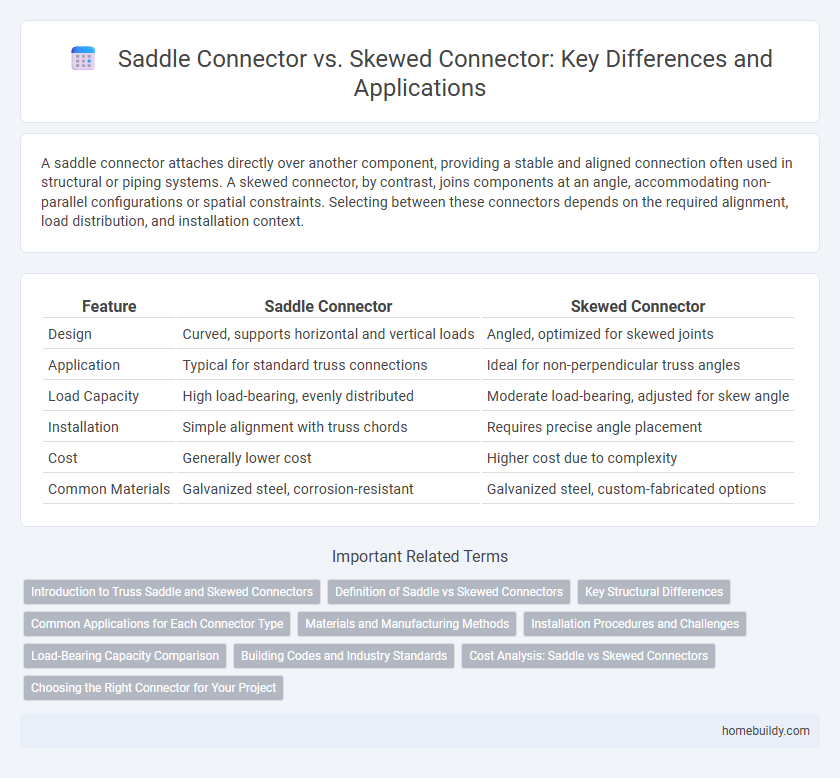A saddle connector attaches directly over another component, providing a stable and aligned connection often used in structural or piping systems. A skewed connector, by contrast, joins components at an angle, accommodating non-parallel configurations or spatial constraints. Selecting between these connectors depends on the required alignment, load distribution, and installation context.
Table of Comparison
| Feature | Saddle Connector | Skewed Connector |
|---|---|---|
| Design | Curved, supports horizontal and vertical loads | Angled, optimized for skewed joints |
| Application | Typical for standard truss connections | Ideal for non-perpendicular truss angles |
| Load Capacity | High load-bearing, evenly distributed | Moderate load-bearing, adjusted for skew angle |
| Installation | Simple alignment with truss chords | Requires precise angle placement |
| Cost | Generally lower cost | Higher cost due to complexity |
| Common Materials | Galvanized steel, corrosion-resistant | Galvanized steel, custom-fabricated options |
Introduction to Truss Saddle and Skewed Connectors
Truss saddle connectors securely cradle the truss bottom chord, providing stable support and optimal load distribution in straight or slightly curved truss applications. Skewed connectors accommodate angled or non-perpendicular truss intersections, enabling precise alignment and strong joint integrity in complex framing layouts. Both connector types enhance truss performance by addressing specific directional and load-bearing requirements within structural wood frameworks.
Definition of Saddle vs Skewed Connectors
Saddle connectors are specialized truss connectors designed to fit snugly over the top chord of a truss, providing a secure and stable connection point that distributes loads evenly across the joint. Skewed connectors, in contrast, are engineered to accommodate angled or offset truss intersections where typical perpendicular connections are not feasible, ensuring structural integrity in non-orthogonal configurations. Both connector types enhance truss performance by addressing specific geometric requirements and load distribution challenges in timber framing and construction applications.
Key Structural Differences
Saddle connectors feature a curved base that fits snugly over the top chord of a truss, providing uniform load distribution and enhanced stability in vertical alignments. Skewed connectors, designed for angled or non-perpendicular connections, accommodate irregular framing by allowing trusses to be joined at various skew angles without compromising structural integrity. The key structural difference lies in the saddle connector's emphasis on direct load transfer and alignment, while skewed connectors optimize joint strength in angular configurations.
Common Applications for Each Connector Type
Saddle connectors are commonly used in wood-to-wood connections where the truss meets a beam or support, providing excellent load distribution and stability in roof and floor framing systems. Skewed connectors are typically applied in angled or offset joints, such as in complex roof designs or irregularly shaped trusses, allowing secure fastening in non-perpendicular intersections. Both connector types enhance structural integrity but cater to different geometric and load-bearing requirements in residential and commercial construction.
Materials and Manufacturing Methods
Saddle connectors are typically made from galvanized steel, offering corrosion resistance and durability through a stamping or pressing manufacturing process that ensures uniform thickness and strength. Skewed connectors often use stainless steel or advanced alloys to withstand angled stresses, produced via precision laser cutting or CNC machining to achieve intricate shapes and enhanced structural integrity. Both types leverage materials and manufacturing methods tailored to optimize load distribution and long-term performance in truss applications.
Installation Procedures and Challenges
Saddle connectors typically require precise alignment with truss chords, demanding careful positioning and secure fastening to ensure load transfer efficiency, which can be labor-intensive in confined spaces. Skewed connectors involve angled installation to accommodate non-perpendicular truss intersections, requiring specialized tools and meticulous measurement to prevent structural misalignment and compromised joint integrity. Both types present challenges in maintaining consistent fastening torque and avoiding wood splitting, highlighting the importance of skilled labor and proper fastening techniques during installation.
Load-Bearing Capacity Comparison
Saddle connectors offer superior load-bearing capacity due to their larger surface contact area with truss chords, distributing forces more evenly and minimizing stress concentrations. Skewed connectors, while beneficial for angled or irregular truss connections, typically exhibit reduced load-bearing capacity because the inclined orientation generates uneven force distribution and potential stress points. Structural engineers often prefer saddle connectors in high-load applications to ensure optimal strength and durability in truss assemblies.
Building Codes and Industry Standards
Saddle connectors comply with the International Residential Code (IRC) for typical roof truss applications, providing standardized load transfer and ease of installation. Skewed connectors require specific evaluation under the National Design Specification (NDS) to address angled load paths and ensure adequate capacity per building code requirements. Industry standards from the American Wood Council (AWC) emphasize proper testing and engineering judgment for skewed connectors to meet safety and performance criteria.
Cost Analysis: Saddle vs Skewed Connectors
Saddle connectors typically incur lower installation costs due to simpler alignment and fewer specialized tools required, making them cost-effective for standard truss connections. Skewed connectors, while offering greater flexibility in angled or irregular truss designs, often demand higher labor and fabrication expenses due to their complex geometry. Overall, the choice between saddle and skewed connectors should consider not only material costs but also installation efficiency and project-specific design requirements to optimize budget allocation.
Choosing the Right Connector for Your Project
Selecting the appropriate truss connector depends on the specific roof design and load requirements, with saddle connectors providing strong, stable support for perpendicular truss installation. Skewed connectors are ideal for angled or non-typical roof configurations, ensuring secure connections where standard saddle connectors may not fit properly. Evaluating factors such as roof pitch, structural load, and installation angle is critical to optimize structural integrity and compliance with building codes.
Saddle connector vs skewed connector Infographic

 homebuildy.com
homebuildy.com